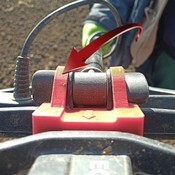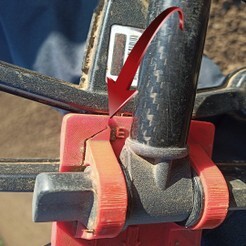coil strengtheners 3d printed
Published by David Wallace in accessories · Sunday 07 Jan 2024
 ARE Coil Strengtheners any good?
ARE Coil Strengtheners any good?
Generally they are not needed but some peopke seem to have jumped on a small issue with a very few coil lugs breaking, and selling 3d printed lug strengtheners to try an eliviate the problem, 90% of the time it is lack of maintenance on the small teardrop washers on the lower shaft where the coil conncts, once worn then the user just keeps on tightening until the inevitable is going to happen, for a small cost of new teardrop washers every few months to keep them fresh you can buy them HERE.
if you do decide you NEED one them please make sure they are manufactured properly, also fitting these could harm your warranty, then you will have either a new coil purchase or a repair which can be done by Crawfords Metal Detectors or a kit to do it yourself.
These are appearing for most brands of metal detectors and cheaply made.
What to look for on 3d printed products.
The quality of 3D printed coil lug strengtheners can vary based on several factors:
Material: The type of material used in 3D printing can significantly impact the strength and durability of the strengthener. Some filaments, like certain types of ABS or nylon, offer good durability and strength, suitable for protecting the coil lug.
Design: The design of the strengthener plays a critical role. A well-engineered design that provides adequate support and protection to the coil lug can be effective, regardless of the manufacturing method.
Printing Quality: The precision and quality of the 3D printing process are essential. Higher-quality printers and skilled operators can produce stronger and more reliable parts compared to lower-quality printing.
Fit and Compatibility: Ensuring the strengthener is designed to fit your specific metal detector model is crucial. A well-fitting strengthener will provide better protection and support.
MOST of these 3d printed products are made by people just wanting to get some money out of your pocket and no thought or design has gone into these products.
3D printed coil lug strengtheners can potentially be printed in ways that affect their effectiveness. Some common issues that might arise during the 3D printing process include:
 Incorrect Orientation: Printing orientation matters. Printing the strengthener in the wrong orientation might weaken its structural integrity or compromise its fit.
Incorrect Orientation: Printing orientation matters. Printing the strengthener in the wrong orientation might weaken its structural integrity or compromise its fit.
Poor Layer Adhesion: If the printer settings or the material used are not suitable, it can result in weak layer adhesion, making the strengthener less durable.
 Incorrect Orientation: Printing orientation matters. Printing the strengthener in the wrong orientation might weaken its structural integrity or compromise its fit.
Incorrect Orientation: Printing orientation matters. Printing the strengthener in the wrong orientation might weaken its structural integrity or compromise its fit.Printing Defects: Issues like warping, stringing, or misalignment during printing can lead to a weaker final product, reducing its ability to protect and reinforce the coil lug.
Material Choice: Not all 3D printing materials offer the same level of strength or durability. Choosing a material ill-suited for the purpose can result in a weaker strengthener.
Design Flaws: A poorly designed strengthener might not provide adequate protection or support to the coil lug, regardless of the printing quality.
It's essential to have the right settings, suitable materials, and a well-designed model to ensure the 3D printed coil lug strengthener comes out correctly.
Other 3d printed items including charge port covers, coil bumpers, and control box 3d printed bumper things for the Manticore, Equinox and XTerra pro are also starting to appear on selling sites, these are COSMETIC and not needed.
your best protection for the detectors brains will be a custom made control box cover from the majority of leading uk detecting stores and detecting magazines.
For protecting the carbon shafts and to hide the coil cable the best and cheapest method is to use an old bike innertube.
2 reviews
